Elagabalus
Elagabalus[2] or Heliogabalus[3] (c. 204 – 11 March 222) was Roman emperor from 218 to 222. A member of the Severan dynasty, he was the second son of Julia Soaemias and Sextus Varius Marcellus. In his early youth he served the god Elagabalus as a priest in Emesa, Syria, the hometown of his mother's family, the Arab priest-king Emesan dynasty. As a private citizen, he was probably named Sextus Varius Avitus Bassianus.[4] Upon becoming emperor he took the name Marcus Aurelius Antoninus. He was called Elagabalus only after his death.[5]
| Elagabalus | |||||||||
|---|---|---|---|---|---|---|---|---|---|
.jpg) Head of Elagabalus, from the Capitoline Museums | |||||||||
| Roman emperor | |||||||||
| Reign | 16 May 218 – 11 March 222 | ||||||||
| Predecessor | Macrinus | ||||||||
| Successor | Severus Alexander | ||||||||
| Born | c. 204 Emesa, Syria or Rome | ||||||||
| Died | 11 March 222 (aged around 18) Murdered at Rome | ||||||||
| Burial | Corpse thrown into the Tiber | ||||||||
| Supposed spouse | |||||||||
| Issue | Severus Alexander (adoptive) | ||||||||
| |||||||||
| Dynasty | Severan | ||||||||
| Father | Sextus Varius Marcellus | ||||||||
| Mother | Julia Soaemias Bassiana | ||||||||
| Roman imperial dynasties | ||
|---|---|---|
| Severan dynasty | ||
| Chronology | ||
| 193–211 | ||
|
—with Caracalla 198–211 |
||
|
—with Geta 209–211 |
||
| 211 | ||
| 211–217 | ||
|
Interlude: Macrinus 217–218 |
||
|
—with Diadumenian 217–218 |
||
| 218–222 | ||
| 222–235 | ||
| Dynasty | ||
| Severan dynasty family tree | ||
|
All biographies |
||
| Succession | ||
|
In 217, the emperor Caracalla was assassinated and replaced by his Praetorian prefect, Marcus Opellius Macrinus. Caracalla's maternal aunt, Julia Maesa, successfully instigated a revolt among the Third Legion to have her eldest grandson (and Caracalla's cousin), Elagabalus, declared emperor in his place. Macrinus was defeated on 8 June 218 at the Battle of Antioch. Elagabalus, barely 14 years old, became emperor, initiating a reign remembered mainly for sex scandals and religious controversy.
Later historians suggest Elagabalus showed a disregard for Roman religious traditions and sexual taboos. He replaced the traditional head of the Roman pantheon, Jupiter, with the deity Elagabalus, of whom he had been high priest. He forced leading members of Rome's government to participate in religious rites celebrating this deity, over which he personally presided. Elagabalus married four women, and lavished favours on male courtiers popularly thought to have been his lovers.[6][7] He was also reported to have prostituted himself.[8] His behavior estranged the Praetorian Guard, the Senate, and the common people alike. Amidst growing opposition, Elagabalus, just 18 years old, was assassinated and replaced by his cousin Severus Alexander on 11 March 222, who ruled for 13 years before his own assassination, which marked the epoch event for the Crisis of the Third Century. The assassination plot against Elagabalus was devised by his grandmother, Julia Maesa, and carried out by disaffected members of the Praetorian Guard.
Elagabalus developed a reputation among his contemporaries for extreme eccentricity, decadence, and zealotry.[9] This tradition has persisted, and with writers of the early modern age he suffers one of the worst reputations among Roman emperors. Edward Gibbon, for example, wrote that Elagabalus "abandoned himself to the grossest pleasures with ungoverned fury".[10] According to Barthold Georg Niebuhr, "The name Elagabalus is branded in history above all others" because of his "unspeakably disgusting life".[11] An example of a modern historian's assessment would be Adrian Goldsworthy's: "Elagabalus was not a tyrant, but he was an incompetent, probably the least able emperor Rome had ever had."[12]
Elagabalus is considered by some to be an early transgender figure and one of the first on record as seeking sex reassignment surgery.[13][14]
Family and priesthood
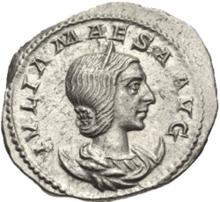
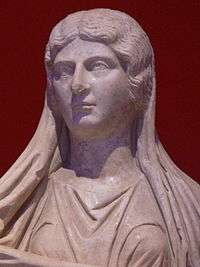
Elagabalus was born in the year 203 or 204,[15][16] to Sextus Varius Marcellus and Julia Soaemias Bassiana,[17] who had married around the year 200.[18] Marcellus was an equestrian, later elevated to the rank of senator sometime before 204.[18][19] Elagabalus's grandmother, Julia Maesa, was the widow of the consul Julius Avitus, the sister of Julia Domna, and the sister-in-law of the emperor Septimius Severus.[18][17] Elagabalus had at least one sibling: an unnamed elder brother.[20][21] His mother, Julia Soaemias, was a cousin of the emperor Caracalla, and there were rumors (which Soaemias later publicly supported) that Elagabalus was Caracalla's child.[19][22] Other relatives included his aunt Julia Avita Mamaea and uncle Marcus Julius Gessius Marcianus and their son Severus Alexander. Elagabalus's family held hereditary rights to the priesthood of the sun god Elagabal, of whom Elagabalus was the high priest at Emesa (modern Homs) in Roman Syria[23] as part of the Arab Emesan dynasty.[24]
The deity Elagabalus was initially venerated at Emesa, and the deity's name is a Latinized version of the Arabic Ilāh ha-Gabal, from ilāh (Arabic for "god") and gabal ("mountain"), meaning "God of the Mountain",[25] the Emesene manifestation of the deity.[26] The deity's cult spread to other parts of the Roman Empire in the 2nd century; a dedication has been found as far away as Woerden (in the Netherlands), near the Roman limes.[27] The god was later imported and assimilated with the Roman sun god known as Sol Indiges in republican times and as Sol Invictus during the second and third centuries CE.[28] In Greek the sun god is Helios, hence "Heliogabalus", a hybrid of "Helios" and "Elagabalus".[29]
Rise to power
_Elagabalus_conduisant_un_char_a_seize_chevaux_blancs%2C_ou%2C_sur_un_autel_de_pierreries%2C_reposait_le_cone_de_pierre_noire.jpg)
When the Emperor Macrinus came to power, he suppressed the threat against his reign from the family of his assassinated predecessor, Caracalla, by exiling them—Julia Maesa, her two daughters, and her eldest grandson Elagabalus—to their estate at Emesa in Syria.[23] Almost upon arrival in Syria, Maesa began a plot with her advisor and Elagabalus' tutor, Gannys, to overthrow Macrinus and elevate the fourteen-year-old Elagabalus to the imperial throne.[23][30]
His mother publicly declared that he was the illegitimate son of Caracalla, and therefore deserving the loyalty of Roman soldiers and senators who had sworn allegiance to Caracalla.[23][31] After Julia Maesa displayed her wealth to the Third Legion at Raphana they swore allegiance to Elagabalus. At sunrise on 16 May 218, Publius Valerius Comazon, commander of the legion, declared him emperor.[32] To strengthen his legitimacy Elagabalus assumed Caracalla's names, Marcus Aurelius Antoninus.[33][34]
In response Macrinus dispatched his Praetorian prefect Ulpius Julianus to the region with a contingent of troops he considered strong enough to crush the rebellion. However, this force soon joined the faction of Elagabalus when, during the battle, they turned on their own commanders. The officers were killed and Julianus' head was sent back to the emperor.[34][35]
Macrinus now sent letters to the Senate denouncing Elagabalus as the False Antoninus and claiming he was insane.[36] Both consuls and other high-ranking members of Rome's leadership condemned Elagabalus, and the Senate subsequently declared war on both Elagabalus and Julia Maesa.[37]
Macrinus and his son, weakened by the desertion of the Second Legion due to bribes and promises circulated by Julia Maesa, were defeated on 8 June 218 at the Battle of Antioch by troops commanded by Gannys.[35] Macrinus fled to Italy, disguised as a courier, but was intercepted near Chalcedon and executed in Cappadocia.[35] His son Diadumenian, sent as a friendly hostage to the Parthian court as a guarantee of peace between the states, was captured at Zeugma and also put to death.[35]
Elagabalus declared the date of the victory at Antioch to be the beginning of his reign and assumed the imperial titles without prior senatorial approval.[38] This violated tradition but was a common practice among 3rd-century emperors nonetheless. Letters of reconciliation were dispatched to Rome extending amnesty to the Senate and recognizing the laws, while also condemning the administration of Macrinus and his son.[39][40]
The senators responded by acknowledging Elagabalus as emperor and accepting his claim to be the son of Caracalla.[41] Caracalla and Julia Domna were both deified by the Senate, both Julia Maesa and Julia Soaemias were elevated to the rank of Augustae,[42] and the memory of both Macrinus and Diadumenian was expunged by the Senate.[38] The former commander of the Third Legion, Comazon, was appointed commander of the Praetorian Guard.[43][44]
Emperor (218–222)
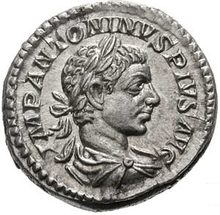
Elagabalus and his entourage spent the winter of 218 in Bithynia at Nicomedia,[41] where the emperor's religious beliefs first presented themselves as a problem. The contemporary historian Cassius Dio suggests that Gannys was in fact killed by the new emperor because he pressured Elagabalus to live "temperately and prudently".[45] To help Romans adjust to having an oriental priest as emperor, Julia Maesa had a painting of Elagabalus in priestly robes sent to Rome and hung over a statue of the goddess Victoria in the Senate House.[41] This placed senators in the awkward position of having to make offerings to Elagabalus whenever they made offerings to Victoria.[46]
The legions were dismayed by his behaviour and quickly came to regret having supported his accession.[47] While Elagabalus was still on his way to Rome, brief revolts broke out by the Fourth Legion at the instigation of Gellius Maximus, and by the Third Legion, which itself had been responsible for the elevation of Elagabalus to the throne, under the command of Senator Verus.[48] The rebellion was quickly put down, and the Third Legion disbanded.[49]
When the entourage reached Rome in the autumn of 219, Comazon and other allies of Julia Maesa and Elagabalus were given powerful and lucrative positions, to the chagrin of many senators who did not consider them worthy of such privileges.[50] After his tenure as Praetorian prefect, Comazon served as the city prefect of Rome three times, and as consul twice.[43] Elagabalus soon devalued the Roman currency. He decreased the silver purity of the denarius from 58% to 46.5% — the actual silver weight dropping from 1.82 grams to 1.41 grams. He also demonetized the antoninianus during this period in Rome.[51]
Elagabalus tried to have his presumed lover, the charioteer Hierocles, declared Caesar,[52] while another alleged lover, the athlete Aurelius Zoticus, was appointed to the non-administrative but influential position of Master of the Chamber, or Cubicularius.[53] His offer of amnesty for the Roman upper class was largely honoured, though the jurist Ulpian was exiled.[54]
The relationships between Julia Maesa, Julia Soaemias, and Elagabalus were strong at first. His mother and grandmother became the first women to be allowed into the Senate,[55] and both received senatorial titles: Soaemias the established title of Clarissima, and Maesa the more unorthodox Mater Castrorum et Senatus ("Mother of the army camp and of the Senate").[42] They held the title of Augusta as well, suggesting that they may have been the power behind the throne. Indeed, they exercised great influence over the young emperor throughout his reign, and can be found on many coins and inscriptions—a rare honor for Roman women.[56]
Religious controversy
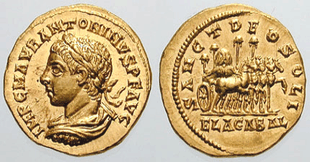
Since the reign of Septimius Severus, sun worship had increased throughout the Empire.[57] Elagabalus saw this as an opportunity to install Elagabal as the chief deity of the Roman pantheon. The god was renamed Deus Sol Invictus, meaning God the Undefeated Sun, and honored above Jupiter.[58]
As a token of respect for Roman religion, however, Elagabalus joined either Astarte, Minerva, Urania, or some combination of the three to Elagabal as consort.[59] A union between Elagabal and a traditional goddess would have served to strengthen ties between the new religion and the imperial cult. In fact, there may have been an effort to introduce Elagabal, Urania, and Athena as the new Capitoline triad of Rome—replacing Jupiter, Juno, and Minerva.[60]
He aroused further discontent when he married the Vestal Virgin Aquilia Severa, claiming the marriage would produce "godlike children".[61] This was a flagrant breach of Roman law and tradition, which held that any Vestal found to have engaged in sexual intercourse was to be buried alive.[62]
A lavish temple called the Elagabalium was built on the east face of the Palatine Hill to house Elagabal, who was represented by a black conical meteorite from Emesa.[41] Herodian wrote "this stone is worshipped as though it were sent from heaven; on it there are some small projecting pieces and markings that are pointed out, which the people would like to believe are a rough picture of the sun, because this is how they see them".[23]
In order to become the high priest of his new religion, Elagabalus had himself circumcised.[58] He forced senators to watch while he danced around the altar of Deus Sol Invictus to the accompaniment of drums and cymbals.[41] Each summer solstice he held a festival dedicated to the god, which became popular with the masses because of the free food distributed on these occasions.[59] During this festival, Elagabalus placed the Emesa stone on a chariot adorned with gold and jewels, which he paraded through the city:
A six horse chariot carried the divinity, the horses huge and flawlessly white, with expensive gold fittings and rich ornaments. No one held the reins, and no one rode in the chariot; the vehicle was escorted as if the god himself were the charioteer. Elagabalus ran backward in front of the chariot, facing the god and holding the horses' reins. He made the whole journey in this reverse fashion, looking up into the face of his god.[59]
The most sacred relics from the Roman religion were transferred from their respective shrines to the Elagabalium, including the emblem of the Great Mother, the fire of Vesta, the Shields of the Salii, and the Palladium, so that no other god could be worshipped except in association with Elagabal.[63]
Marriages, sexuality and gender
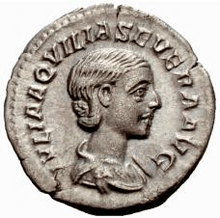
The question of Elagabalus' sexual orientation is confused, owing to salacious and unreliable sources. Cassius Dio states that Elagabalus was married five times (twice to the same woman).[64] His first wife was Julia Cornelia Paula, whom he married prior to August 29, 219; between then and August 28, 220, he divorced Paula, took the Vestal Virgin Julia Aquilia Severa as his second wife, divorced her,[64][65] and took his third wife, whom Herodian says was Annia Aurelia Faustina, a descendant of Marcus Aurelius and the widow of a man he had recently had executed, Pomponius Bassus.[64] In the last year of his reign, Elagabalus divorced Annia Faustina and remarried Aquilia Severa.[64]
Dio states that another "husband of this woman [Elagabalus] was Hierocles", an ex-slave and chariot driver from Caria.[66][7] The Augustan History claims that Elagabalus also married a man named Zoticus, an athlete from Smyrna, while Dio says only that Zoticus was his cubicularius.[7][67] Dio says that Elagabalus prostituted himself in taverns and brothels.[8]
Dio (who referred to Elagabalus with feminine pronouns)[66] says Elagabalus delighted in being called Hierocles' mistress, wife, and queen.[14] The emperor reportedly wore makeup and wigs, preferred to be called a lady and not a lord, and offered vast sums to any physician who could provide him with a vagina;[13][14] for this reason, the emperor is seen by some writers as an early transgender figure and one of the first on record as seeking sex reassignment surgery.[13][14][68][69]
Fall from power
By 221 Elagabalus' eccentricities, particularly his relationship with Hierocles,[52] increasingly provoked the soldiers of the Praetorian Guard.[50] When Elagabalus' grandmother Julia Maesa perceived that popular support for the emperor was waning, she decided that he and his mother, who had encouraged his religious practices, had to be replaced.[50] As alternatives, she turned to her other daughter, Julia Avita Mamaea, and her daughter's son, the fifteen-year-old Severus Alexander.[50]
Prevailing on Elagabalus, she arranged that he appoint his cousin Alexander as his heir and that the boy be given the title of Caesar. Alexander shared the consulship with the emperor that year.[50] However, Elagabalus reconsidered this arrangement when he began to suspect that the Praetorian Guard preferred his cousin to himself.[70]
Following the failure of various attempts on Alexander's life, Elagabalus stripped his cousin of his titles, revoked his consulship, and invented the rumor that Alexander was near death, in order to see how the Praetorians would react.[70] A riot ensued, and the Guard demanded to see Elagabalus and Alexander in the Praetorian camp.[70]
Assassination
.jpg)
The Emperor complied and on 11 March 222 he publicly presented his cousin along with his own mother, Julia Soaemias. On their arrival the soldiers started cheering Alexander while ignoring Elagabalus, who ordered the summary arrest and execution of anyone who had taken part in this display of insubordination.[70] In response, members of the Praetorian Guard attacked Elagabalus and his mother:
He made an attempt to flee, and would have got away somewhere by being placed in a chest had he not been discovered and slain, at the age of eighteen. His mother, who embraced him and clung tightly to him, perished with him; their heads were cut off and their bodies, after being stripped naked, were first dragged all over the city, and then the mother's body was cast aside somewhere or other, while his was thrown into the Tiber.[71]
Following his assassination, many associates of Elagabalus were killed or deposed, including his lover Hierocles.[71] His religious edicts were reversed and the stone of Elagabal was sent back to Emesa.[72] Women were again barred from attending meetings of the Senate.[73][74] The practice of damnatio memoriae—erasing from the public record a disgraced personage formerly of note—was systematically applied in his case.[75] Several images, including an over-life-size statue of him as Hercules that is now in Naples, were re-carved with the face of Alexander Severus.[76]
Sources
Augustan History
The source of many of these stories of Elagabalus's depravity is the Augustan History (Historia Augusta), which includes controversial claims.[77] It is most likely that the Historia Augusta was written towards the end of the 4th century, during the reign of Emperor Theodosius I.[78] The life of Elagabalus as described in the Augustan History is of uncertain historical merit.[79] Sections 13 to 17, relating to the fall of Elagabalus, are less controversial among historians.[80]
Cassius Dio
Sources often considered more credible than the Augustan History include the contemporary historians Cassius Dio and Herodian. Cassius Dio lived from the second half of the 2nd century until sometime after 229. Born into a patrician family, he spent the greater part of his life in public service. He was a senator under emperor Commodus and governor of Smyrna after the death of Septimius Severus. Afterwards, he served as suffect consul around 205, and as proconsul in Africa and Pannonia.[81]
Severus Alexander held him in high esteem and made him his consul again. His Roman History spans nearly a millennium, from the arrival of Aeneas in Italy until the year 229. As a contemporary of Elagabalus, Cassius Dio's account of his reign is generally considered more reliable than the Augustan History, although by his own admission[81] Dio spent the greater part of the relevant period outside of Rome and had to rely on second-hand information.
Furthermore, the political climate in the aftermath of Elagabalus' reign, as well as Dio's own position within the government of Alexander, likely influenced the truth of this part of his history for the worse. Dio regularly refers to Elagabalus as Sardanapalus, partly to distinguish him from his divine namesake,[82] but chiefly to do his part in maintaining the damnatio memoriae and to associate him with another autocrat notorious for a dissolute life.[83]
Herodian
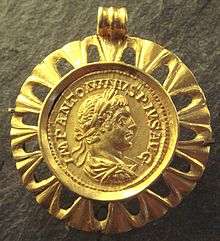
Another contemporary of Elagabalus' was Herodian, a minor Roman civil servant who lived from c. 170 until 240. His work, History of the Roman Empire since Marcus Aurelius, commonly abbreviated as Roman History, is an eyewitness account of the reign of Commodus until the beginning of the reign of Gordian III. His work largely overlaps with Dio's own Roman History, but the texts, written independently of each other, agree more often than not about the emperor and his short but eventful reign.[84]
Although Herodian is not deemed as reliable as Cassius Dio, his lack of literary and scholarly pretensions make him less biased than senatorial historians. Herodian is considered the most important source for the religious reforms which took place during the reign of Elagabalus, which have been confirmed by numismatic[85][86] and archaeological evidence.[87]
Modern historians
For readers of the modern age, The History of the Decline and Fall of the Roman Empire by Edward Gibbon (1737–1794) further cemented the scandalous reputation of Elagabalus. Gibbon not only accepted and expressed outrage at the allegations of the ancient historians, but he might have added some details of his own; he is the first historian known to claim that Gannys was a eunuch, for example.[88] Gibbon wrote:
To confound the order of the season and climate, to sport with the passions and prejudices of his subjects, and to subvert every law of nature and decency, were in the number of his most delicious amusements. A long train of concubines, and a rapid succession of wives, among whom was a vestal virgin, ravished by force from her sacred asylum, were insufficient to satisfy the impotence of his passions. The master of the Roman world affected to copy the manners and dress of the female sex, preferring the distaff to the sceptre, and dishonored the principal dignities of the empire by distributing them among his numerous lovers; one of whom was publicly invested with the title and authority of the emperor's, or, as he more properly styled himself, the empress's husband. It may seem probable, the vices and follies of Elagabalus have been adorned by fancy, and blackened by prejudice. Yet, confining ourselves to the public scenes displayed before the Roman people, and attested by grave and contemporary historians, their inexpressible infamy surpasses that of any other age or country.[89]
The 20th-century anthropologist James George Frazer (author of The Golden Bough) took seriously the monotheistic aspirations of the emperor, but also ridiculed him: "The dainty priest of the Sun [was] the most abandoned reprobate who ever sat upon a throne ... It was the intention of this eminently religious but crack-brained despot to supersede the worship of all the gods, not only at Rome but throughout the world, by the single worship of Elagabalus or the Sun."[90]
The first book-length biography was The Amazing Emperor Heliogabalus (1911) by J. Stuart Hay, "a serious and systematic study"[91] more sympathetic than that of previous historians, which nonetheless stressed the exoticism of Elagabalus, calling his reign one of "enormous wealth and excessive prodigality, luxury and aestheticism, carried to their ultimate extreme, and sensuality in all the refinements of its Eastern habit".[92]
Some recent historians paint a more favorable picture of the emperor's rule. Martijn Icks, in Images of Elagabalus (2008; republished as The Crimes of Elagabalus in 2012), doubts the reliability of the ancient sources and argues that it was the emperor's unorthodox religious policies that alienated the power elite of Rome, to the point that his grandmother saw fit to eliminate him and replace him with his cousin. Leonardo de Arrizabalaga y Prado, in The Emperor Elagabalus: Fact or Fiction? (2008), is also critical of the ancient historians and speculates that neither religion nor sexuality played a role in the fall of the young emperor. He was simply the loser in a power struggle within the imperial family; the loyalty of the Praetorian Guards was up for sale, and Julia Maesa had the resources to outmaneuver and outbribe her grandson. In this version of events, once Elagabalus, his mother, and his immediate circle had been murdered, a campaign of character assassination began, resulting in a grotesque caricature that has persisted to the present day.
Legacy
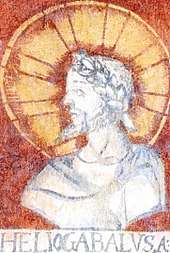
Due to the ancient stories about him, Elagabalus became something of an (anti-)hero in the Decadent movement of the late 19th century.[68] He often appears in literature and other creative media as the epitome of a young, amoral aesthete. His life and character have informed or at least inspired many famous works of art, especially by Decadents, and by contemporary artists. The most notable of these works include:[93]
Fiction
- L'Agonie (1888), a historical novel by Jean Lombard; reprinted in 1902 with illustrations by Auguste Leroux[94]
- De berg van licht (The mountain of light) (1905–06), a historical novel by Louis Couperus
- Héliogabale ou l'Anarchiste couronné (Heliogabalus or The Anarchist Crowned) (1934) by Antonin Artaud, combining essay, biography, and fiction
- Family Favourites (novel) (1960), a historical novel by Alfred Duggan in which an ordinary Roman soldier witnesses the reign of Elagabalus
- Child of the Sun (novel) (1966), a historical novel by Kyle Onstott and Lance Horner
- Being an Account of the Life and Death of the Emperor Heliogabolus [sic] – A 24 Hour Comic (1992), limited edition comic book by Neil Gaiman
- In the lovecraftian-occult video game Cultist Simulator, Chritopher Illopoly describes Heliogabalus as an avatar or an Immortal servant of a God-like being called Sun-in-Rags
Plays
- Heliogabalus: A Buffoonery in Three Acts (1920) by H. L. Mencken and George Jean Nathan[95]
- Heliogabalus: A Love Story (2002) by Sky Gilbert[96]
Dance
- Héliogabale, a modern dance choreographed by Maurice Béjart
- The Legends, a dance performed by Sebastian Droste in which he performed as Heliogabalus. The dance was part of the Dances of Vice, Horror and Ecstasy performance staged by Droste and Anita Berber in 1923.
Music
- Eliogabalo (1667), an opera by Venetian Baroque composer Francesco Cavalli
- Elagabalus is mentioned in the Major-General's Song (1879) from Gilbert and Sullivan's The Pirates of Penzance.[97]
- Heliogabale (1910), an opera by French composer Déodat de Séverac
- Eliogabalus (1990), title of both the second album and second song by the experimental rock band Devil Doll (Slovenian band)
- Heliogabalus imperator (Emperor Heliogabalus) (1972), an orchestral work by the German composer Hans Werner Henze
- Six Litanies for Heliogabalus (2007), an album by American musician John Zorn
- The Pale Emperor (2015), an album by American musician Marilyn Manson, was inspired by the life of Heliogabalus and more specifically Antonin Artaud's book[98][99]
Paintings
- Heliogabalus, High Priest of the Sun (1866), by Pre-Raphaelite Simeon Solomon
- One of the most notorious incidents laid to his account[100] is immortalized in the 19th-century painting The Roses of Heliogabalus (1888), by the Anglo-Dutch academician Sir Lawrence Alma-Tadema. It shows guests at one of his extravagant dinner parties smothered under a mass of "violets and other flowers" dropped from above.
- Antonin Artaud Heliogabalus (2010–11), by Anselm Kiefer[101]
Poetry
- Algabal (1892–1919), a collection of poems by Stefan George
- In "He 'Digesteth Harde Yron'" American poet Marianne Moore describes a banquet at which Elagabalus served six hundred ostrich brains, a detail she found in George Jennison's book Animals for Show and Pleasure in Ancient Rome.
Television
- In CBBC's adaptation of Horrible Histories, Elagabalus is portrayed by Mathew Baynton as a laddish teenager with a cruel sense of humour.
Vocabulary
- The Spanish word heliogábalo means "a person overwhelmed by gluttony".[102]
References
- Cooley, Alison E. (2012). The Cambridge Manual of Latin Epigraphy. Cambridge University Press. p. 496. ISBN 978-0-521-84026-2.
- /ˌɛləˈɡæbələs/ EL-ə-GAB-ə-ləs
- /ˌhiːliə-, -lioʊ-/ HEE-lee-ə-, -lee-oh-; "Heliogabalus". The American Heritage Dictionary of the English Language (5th ed.). Boston: Houghton Mifflin Harcourt. Retrieved 2019-11-06.
- For a detailed discussion of his nomenclature, see Leonardo de Arrizabalaga y Prado, Elagabalus: Fact or Fiction?, p. 231.
- The first known instance is in the Chronography of 354, in the list of emperors in the section titled Chronica Urbis Romae, where he is called Antoninus Elagaballus.
- Scott (2018), pp. 129-130, 135-137
- Aleardo Zanghellini, The Sexual Constitution of Political Authority, Routledge, 2015, ISBN 9781134067060, page 59
- Domitilla Campanile, Filippo Carlà-Uhink, Margherita Facella, TransAntiquity: Cross-Dressing and Transgender Dynamics in the Ancient World, Routledge, 2017, ISBN 9781317377375, page 113
- Potter, David Stone (2004). The Roman Empire at Bay: Ad 180–395. Routledge. ISBN 0-415-10057-7.
- Gibbon, Edward. Decline and Fall of the Roman Empire, Chapter VI.
- Niebuhr, B.G. History of Rome, p. 144 (1844). Elagabalus' vices were "too disgusting even to allude to them".
- Goldsworthy, Adrian. How Rome Fell, Chapter 3.
- Tess deCarlo, Trans History (ISBN 1387846353), page 32
- Varner, Eric (2008). "Transcending Gender: Assimilation, Identity, and Roman Imperial Portraits". Memoirs of the American Academy in Rome. Supplementary volume. Ann Arbor, Michigan: University of Michigan Press. 7: 200–201. ISSN 1940-0977. JSTOR 40379354. OCLC 263448435.
Elagabalus is also alleged to have appeared as Venus and to have depilated his entire body. ... Dio recounts an exchange between Elagabalus and the well-endowed Aurelius Zoticus: when Zoticus addressed the emperor as 'my lord,' Elagabalus responded, 'Don't call me lord, I am a lady.' Dio concludes his anecdote by having Elagabalus asking his physicians to give him the equivalent of a woman's vagina by means of a surgical incision.
- Jasper Burns, Great Women of Imperial Rome: Mothers and Wives of the Caesars, 2006, page 215
- Barbara Levick, Julia Domna: Syrian Empress, page 93: "Elagabalus, born in 203 or 204"
- Scott (2018), pp. 83-84
- Fergus Millar, The Roman Near East, 31 B.C.-A.D. 337, 1993, page 119
- Lukas de Blois, Image and Reality of Roman Imperial Power in the Third Century AD, 2018, page 72
- Birley, Septimius Severus: The African Emperor, pp. 217, 222-223
- Sextus Varius Marcellus' article at Livius.org
- Marjorie Lightman, Benjamin Lightman, A to Z of Ancient Greek and Roman Women, 2008, page 174
- Herodian, Roman History V.3
- Ball, Warwick (2002). Rome in the East. Routledge. p. 35.
- The Journal of Juristic Papyrology, volume 23, page 116: "und mit palmyrenischer Inschrift "Gott Berg" steht die umstrittene Etymologie des Namens "Elagabal" (ilah ha-gabal) fest"
- Ball, Warwick (2002). Rome in the East. Routledge. p. 37.
- "An Early Dedication to Elagabal" at Livius.org; the inscription is now in Woerden's city museum.
- Devlaminck, Pieter (2004). "De Cultus van Sol Invictus: Een vergelijkende studie tussen keizer Elagabalus (218–222) en keizer Aurelianus (270–275)" (in Dutch). University of Ghent. Retrieved 2007-08-07.
- Icks (2011), p. 227
- Walter J. Whittemore Jr., Untimely Deaths by Assassination. (2012) p.33
- Icks, (2011) p. 11
- Cassius Dio, Roman History LXXIX.31
- Cassius Dio, Roman History LXXIX.32
- Icks, (2011) p. 12
- Herodian, Roman History V.4
- Cassius Dio, Roman History LXXIX.36
- Cassius Dio, Roman History LXXIX.38
- Cassius Dio, Roman History LXXX.2
- Cassius Dio, Roman History LXXX.1
- Icks, (2011) p.14
- Herodian, Roman History V.5
- Benario, Herbert W. (1959). "The Titulature of Julia Soaemias and Julia Mamaea: Two Notes". Transactions and Proceedings of the American Philological Association. Transactions and Proceedings of the American Philological Association, Vol. 90. 90: 9–14. doi:10.2307/283691. JSTOR 283691.
- Cassius Dio, Roman History LXXX.4
- Icks, (2011) p. 20
- Cassius Dio, Roman History LXXX.6
- van Zoonen, Lauren (2005). "Heliogabalus". livius.org. Retrieved 10 July 2016
- Augustan History, Life of Elagabalus 5
- Cassius Dio, Roman History LXXX.7
- van Zoonen, Lauren (2005). "Heliogabalus". livius.org. Retrieved 2007-08-18.
- Herodian, Roman History V.7
- Tulane University "Roman Currency of the Principate" Archived November 1, 2008, at the Wayback Machine
- Cassius Dio, Roman History LXXX.15
- Cassius Dio, Roman History LXXX.16
- Grant, (1996) p. 51
- Jasper Burns, Great Women of Imperial Rome: Mothers and Wives of the Caesars (2007) p. 214
- Icks, (2011) p. 19
- Halsberghe, Gaston H. (1972). The Cult of Sol Invictus. Leiden: Brill. p. 36.
- Cassius Dio, Roman History LXXX.11
- Herodian, Roman History V.6
- Icks, (2011), pp. 32–33
- Cassius Dio, Roman History LXXX.9
- Plutarch, Parallel Lives, Life of Numa Pompilius, 10
- Icks, (2011) p. 113
- Andrew G. Scott, Emperors and Usurpers: An Historical Commentary on Cassius Dio's Roman History, Oxford University Press, 2018, ISBN 9780190879600, paged 129-130
- Grant (1996), p. 25
- Scott (2018), pp. 135-136
- Scott (2018), pp. 136-137
- Godbout, Louis (2004). "Elagabalus" (PDF). GLBTQ: An Encyclopedia of Gay, Lesbian, Bisexual, Transgender, and Queer Culture. Chicago: glbtq, Inc. Retrieved 6 August 2007.
- Benjamin, Harry; Green, Richard (1966). The Transsexual Phenomenon, Appendix C: Transsexualism: Mythological, Historical, and Cross-Cultural Aspects. New York: The Julian Press, Inc. Archived from the original on 2007-07-17. Retrieved 3 August 2007.
- Herodian, Roman History V.8
- Cassius Dio, Roman History LXXX.20
- Herodian, Roman History VI.6
- Augustan History, Life of Elagabalus 4
- Hay, J. Stuart (1911). The Amazing Emperor Heliogabalus. London: MacMillan. p. 124. Archived from the original on 2008-02-02. Retrieved 2008-05-03.
- Hans Willer Laale, Ephesus (Ephesos): An Abbreviated History From Androclus to Constantine XI (2011) p. 269
- Varner, Eric R., Monumenta Graeca et Romana: Mutilation and transformation : damnatio memoriae and Roman imperial portraiture, pp. 192–194, 2004, BRILL, ISBN 9004135774, 9789004135772, google books
- Syme, Ronald (1971). Emperors and biography: studies in the 'Historia Augusta'. Oxford: Clarendon Press. p. 218. ISBN 0-19-814357-5.
- Cizek, Eugen (1995). Histoire et historiens à Rome dans l'Antiquité. Lyon: Presses universitaires de Lyon. p. 297.
- Syme, Ronald (1971). Emperors and biography: studies in the 'Historia Augusta'. Oxford: Clarendon Press. p. 263. ISBN 0-19-814357-5.
- Butler, Orma Fitch (1910). "Studies in the life of Heliogabalus". University of Michigan studies: Humanistic series IV. New York: MacMillan: 140.
- chapter 80.18
- 80.11–12
- Syme, Ronald (1971). Emperors and biography: studies in the 'Historia Augusta'. Oxford: Clarendon Press. pp. 145–146. ISBN 0-19-814357-5.
- Lendering, Jona (2004). "Herodian". Livius.org. Retrieved 2008-05-03.
- Cohen, Henry (1880–1892). Description Historiques des Monnaies Frappées sous l'Empire Romain. Paris. p. 40.
- Babelon, Ernest Charles François (1885–1886). Monnaies Consulaires II. Bologna: Forni. pp. 63–69.
- Corpus Inscriptionum Latinarum, CIL II, 1409, CIL II, 1410, CIL II, 1413, and CIL III: 564–589.
- Leonardo de Arrizabalaga y Prado, "Pseudo-Eunuchs in the Court of Elagabalus", 1999, p. 4.
- Gibbon, Edward, The History of the Decline and Fall of the Roman Empire, Chapter VI
- Fraser, J. G., The Worship of Nature, Volume I, London: MacMillan and Co., 1926, pp. 496–498.
- J. B. Bury in introduction to Hay 1911, p. xxiii
- Hay 1911, p. 2
- For detailed lists of the appearance of Elagabalus in various media, and a critical evaluation of some of these works, see Martijn Icks, The Crimes of Elagabalus: The Life and Legacy of Rome's Decadent Boy Emperor (London, 2012), pages 219–224.
- L'Agonie
- Mencken, H. L. & Nathan, George Jean (1920). Heliogabalus: A Buffoonery in Three Acts. New York: Alfred A. Knopf.
- Gilbert, Sky (2002). Heliogabalus: A Love Story. Toronto: Cabaret Theatre Company.
- "I Am the Very Model of a Modern Major-General". Retrieved 29 June 2019.
- "Marilyn Manson: The Devil Beneath My Feet". Revolver. 2015-03-01. Retrieved 2018-03-12.
- "Marilyn Manson Explains His Life-Long Love Affair With Makeup". The FADER. Retrieved 2018-03-12.
- "Life of Elagabalus". Augustan History. p. 19].
- Anselm Kiefer – Antonin Artaud Heliogabalus – 2010–11 – courtesy White Cube, Londra – photo Ben Westoby (in Italian). Artribune. 21 February 2012.
- heliogábalo in the Diccionario de la Real Academia Española. Retrieved on 2008-05-03.
Bibliography
Primary sources
- Cassius Dio, Roman History Books 79, and 80, English translation.
- Herodian, Roman History, Book 5, English translation.
- Historia Augusta, The Life of Elagabalus Parts 1 and 2, Latin text with English translation.
Secondary material
- Andrade, Nathanael. "Elagabalus: An Emperor Shrouded in Images", a review of The Crimes of Elagabalus by Martijn Icks. Retrieved 2012-07-16.
- Benjamin, Harry (1966). The Transsexual Phenomenon. New York: The Julian Press, Inc. ISBN 0-446-82426-7. Archived from the original on 2005-04-24. Retrieved 2005-04-27.
- Birley, Anthony R. (1976). Lives of the Later Caesars. Harmondsworth: Penguin. ISBN 0-14-044308-8.
- Birley, Anthony R. (2002). Septimius Severus: The African Emperor. Routledge. ISBN 978-1-138-13416-4. OCLC 1062302222.
- de Arrizabalaga y Prado, Leonardo (2010). The Emperor Elagabulus: Fact or Fiction?. Cambridge, UK: Cambridge University Press. ISBN 978-0-521-89555-2.
- ____. "Pseudo-Eunuchs in the Court of Elagabalus: The Riddle of Gannys, Eutychianus, and Comazon", Collected Papers in Honour of the Ninety-Fifth Anniversary of Ueno Gakuen, Tokyo, 1999, pp. 117–41.
- ____. "Varian Studies: a Definition of the Subject", opening address to the Varian Symposium, Trinity College, Cambridge, 30–31 July 2005.
- Free, Alexander. Review of The Emperor Elagabalus: Fact or Fiction?, Ancient History Bulletin Online Reviews 1 (2011), pp. 98–100.
- Frey, Martin. Untersuchungen zur Religion und der Religionspolitik des Kaisers Elagabalus. Stuttgart, 1989.
- Grant, Michael (1997). The Roman Emperors. Barnes & Noble. pp. 126–130. ISBN 0-7607-0091-5.
- Grant, Michael (1996). The Severans: The Changed Roman Empire. Routledge. ISBN 0-415-12772-6.
- Gualerzi, Saverio (2005). Ne Uomo, Ne Donna, Ne Dio, Ne Dea: Ruolo Sessuale E Ruolo Religioso Dell'imperatore Elagabalo. Bologna: Patron. ISBN 88-555-2842-4.
- Halsberghe, Gaston H. (1972). The Cult of Sol Invictus. Leiden: Brill.
- Hay, J. Stuart. The Amazing Emperor Heliogabalus, with an introduction by J. B. Bury, London: Macmillan and Co, 1911.
- Icks, Martijn (2008). Images of Elagabalus. Nijmegen: Radboud Universiteit. ISBN 978-90-90-23679-7. Reissued as The Crimes of Elagabalus: The Life and Legacy of Rome's Decadent Boy Emperor by Harvard University Press, 2012.
- ____. "Heliogabalus, a Monster on the Roman Throne: The Literary Construction of a 'Bad' Emperor," in Ineke Sluiter and Ralph M. Rosen (eds), Kakos: Badness and Anti-value in Classical Antiquity (Leiden/Boston: Brill, 2008) (Mnemosyne: Supplements. History and Archaeology of Classical Antiquity, 307.
- ____. "Leonardo de Arrizabalaga y Prado: The Emperor Elagabalus".
- ____. "The 'Vices and Follies' of Elagabalus in Modern Historical Research", paper delivered at the Varian Symposium, Trinity College, Cambridge, 30–31 July 2005.
- Krengel, Elke. "Varius' Priestly Vestments", paper delivered at the Varian Symposium, Trinity College, Cambridge, 30–31 July 2005.
- Krumeich, R. "Der Kaiser als syrischer Priester: Zur Repräsentation Elagabals als sacerdos dei Solis Elagabali," Boreas, 23–24, 2000–2001, 107–112.
- Meckler, Michael J. "Elagabalus", published online 26 August 1997.
- Varian Symposium Acta and links for a conference held at Trinity College, Cambridge, 30–31 July 2005.
- Weingarten, Judith. "The Curious Case of Elagabalus' Beard", published online 13 March 2007.
Images
- Wildwinds coin archive: Elagabalus. Large archive of ancient Roman and provincial coins bearing the image of Elagabalus. Retrieved on 2008-05-03.
- Coinarchives coin archive: Elagabalus. Large archive of ancient Roman and provincial coins issued under Elagabalus, including coins of family members. Retrieved on 2008-05-03.
External links


Elagabalus Born: c.204 Died: 11 March 222 | ||
| Regnal titles | ||
|---|---|---|
| Preceded by Macrinus |
Roman emperor 218–222 |
Succeeded by Severus Alexander |
| Political offices | ||
| Preceded by Macrinus M. Oclatinius Adventus |
Consul of the Roman Empire 218–220 with M. Oclatinius Adventus, Q. Tineius Sacerdos, P. Valerius Comazon |
Succeeded by Gaius Vettius Gratus Sabinianus, M. Flavius Vitellius Seleucus |
| Preceded by Gaius Vettius Gratus Sabinianus, M. Flavius Vitellius Seleucus |
Consul of the Roman Empire 222 with M. Aurelius Alexander |
Succeeded by Marius Maximus, L. Roscius Aelianus Paculus Salvius Julianus |
